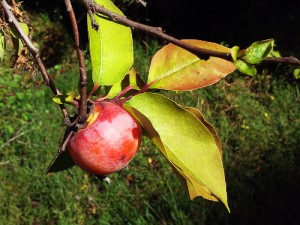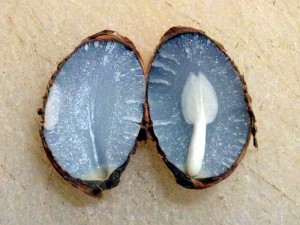 Last weekend I had the occasion to spend time in the woods. I live in the foothills in the Northwest corner of North Carolina. As Fall has begun it’s always interesting to see what fauna emerges in this season. Leaves have begun to fall which has revealed fruit. The muscadine grapes have come and gone but what caught my eye was the quarter sized fruit on a tree. Much like plumbs this fruit has a frosty looking surface with similar texture and feel. Their stem attachment point has a slight leafy skirt. They are wild persimmons!
Last weekend I had the occasion to spend time in the woods. I live in the foothills in the Northwest corner of North Carolina. As Fall has begun it’s always interesting to see what fauna emerges in this season. Leaves have begun to fall which has revealed fruit. The muscadine grapes have come and gone but what caught my eye was the quarter sized fruit on a tree. Much like plumbs this fruit has a frosty looking surface with similar texture and feel. Their stem attachment point has a slight leafy skirt. They are wild persimmons!
Persimmon trees often are found at the edge of the woods and I have seen them often in conjunction with conifers. Many times I’ve discovered their ripened fruit on the ground only to look up and to see the bounty above. Most animals love to eat them so it’s not uncommon to see their large seeds in animal scat during this season.
Their color is often a dull pinkish-orange and as they ripen they become darker in color. When they are mushy to feel and slightly transparent they are ripe to eat. When ripe they are sweet, but when unripe they can make your mouth pucker up. A friend once asked me “how can you tell when persimmons are ripe? Hand one to your friend and tell them to take a bite!”

There is also a folktale associated with their ability to forecast the coming Winter’s weather. If you crack open their seeds edgewise they will reveal an interesting image of a spoon, knife, or fork which translates as follows:
SPOON = lots of snow (like a shovel to clear many snowfalls)
KNIFE = cold winter (like a pick for breaking ice off the top of livestock water troughs)
FORK = a long winter (like a pitchfork for bringing cattle lots of hay until grass emerges)
Some folks will harvest the whole lot of persimmons from a tree which includes both ripe and unripe fruit. They will pick out the ripe ones and ripen the remainder by placing them in a plastic bag along with an apple or two because the apples release ethylene gas that expedites ripening.
The persimmon pulp is often used to make jams and preserves but I enjoy eating them right off of the tree. It adds to the outdoor experience and is a delight when wildcrafting in the woods.


